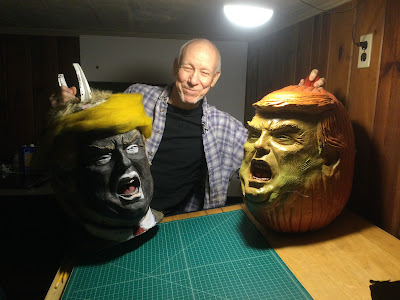After a night in the forest, camping at its best, I was back camping behind a building for the fifth time in six nights, though this time it was fully sanctified, the home of an old classmate of Janina’s from her collegiate days at Indiana University, who lives in Irving, west of Dallas. I could have slept inside, but my preference is always for the tent.
I had met Greg eight years ago, when Janina and I included him on a drive around the South visiting friends, and took an immediate liking to him. He’s an athlete/artist whose Cow Pope Mobile caused quite a stir in the 2002 Art Car Parade. There had been some big changes in his life since then. He had retired from his teaching position and head of the art department at the Dallas branch of the University of Texas, and had moved into an old stone farmhouse with a huge yard that one prospective buyer wanted to break into three lots.
He hated to give up the house he had lived in for over twenty years, but the railroad behind him had increased its use and it had become untenable. He was okay with the neighbor’s roosters, but not the roar of the locomotives. He couldn’t be happier with his new location, two miles from his studio and half a mile from a bike path that leads to Dallas seven miles to the east. He wouldn’t be biking for a while though, as he had just had a horrific, freak bike accident when he fell failing to unclip his pedals and snapped his arm, leaving him with ten inches of fresh stitches from his bicep down. His forearm and hand were still purplish and swollen. The doctors discovered he had an infection that had weakened his bones, resulting in the calamitous break. All his friends say he should give up the bike, but he’s not prepared to do that.Among his latest art projections were a couple related to Trump, one entitled Trumpkin and the other Deep Fake. Deep Fake came with a witch’s cap with Hoax on it and an elaborate accompaniment including a full size piano and a six foot tall Statue of Liberty beneath it befouled by Trump’s slime.
The statue normally resides in his yard. All his neighbors missed it, asking “Where’s Lady Liberty,?” during its several months absence while it did time in a gallery.
It was the second Statue of Liberty of the day for me, as I had seen one of those “Strengthen the Arm of Liberty” statues the Boy Scouts had distributed around the country in 1950 in commemoration of its fortieth anniversary. Dallas has one near the Cotton Bowl in a huge park with many museums. The Statue was by the museum devoted to the state’s history. It was greatly dwarfed by the many other larger statues on the grounds. It had slipped my mind to seek out the statues in Arkansas and Oklahoma, which was a drastic oversight as there were some in towns I had been to including Fayetteville. Texas has four others, only one of which i can include in my traversing around this huge state the size of France.
I was lucky to be arriving in Dallas on a Saturday, as the traffic was greatly reduced entering and passing through the city. The downtown wasn’t without tourists, as I passed a group of cyclists in matching vests being led around to the various assassination sites and another group on Segways.I rode on a frontage road with no traffic alongside a busy four-laner for quite a few of the thirty-five miles from Terrell to the east where I enjoyed my first spontaneous, orgiastic wow of this trip upon sighting its Carnegie. I approached it on a quiet residential street when all of a sudden there was this spectacular, majestic building. “Wow” was the only response one could have. It was adorned with three names—Carnegie high above and Homer and Virgil in almost the same sized letting above two windows below.
It is now a museum. A corner was devoted to Carnegie with his official portrait and photos of the thirty-three libraries he funded in Texas, twenty of which have been razed, including the first four dating to 1899, two in Dallas and two in Houston. One of those in Houston was referred to as a “segregated library.”
The exhibit also included a four-cent stamp of Carnegie issued in 1960.
The museum was the first building I’d entered in a while that required masks. My travels prompted the woman in charge to tell me about a story she’d just read in the Washington Post about a Mexican who had won the New York marathon years ago who was presently running the length of Mexico in marathon segments.









No comments:
Post a Comment